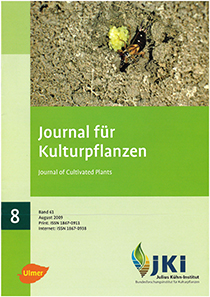Newly characterized pathogenicity-correlated genes are suitable in a PCR-test for a further differentiation of <em>Fusarium oxysporum</em> f. sp. <em>lycopersici</em>-isolates from the JKI strain collection
DOI:
https://doi.org/10.5073/JfK.2009.08.02Keywords:
JKI strain collection, Fusarium oxysporum forma specialis lycopersici, conditional dispensable chromosome, PCR-test, polyphyletic isolatesAbstract
Fusarium oxysporum forma specialis (f. sp.) lycopersici was evaluated as an example from the JKI strain collection to detect the occurrence of the pathogenicity-correlated conditional dispensable (CD) chromosome via PCR. Only in Fusarium oxysporum f. sp. lycopersici the CD-chromosome could be detected, while it was not detected in the closely related F. sp. radicis-lycopersici.
The theory of a transfer of the CD-chromosome into different clonal lines of F. oxysporum was tested by the application of partly-specific primers to investigate the chromosomal background of each isolate. Ten conserved Fusarium oxysporum f. sp. lycopersici isolates of the JKI strain collection were clearly differentiated into two chromosomal categories, when three partly-specific primer pairs were applied. With these experiments it could be shown that Fusarium oxysporum f. sp. lycopersici was polyphyletic, i. e. there are two different Fusarium oxysporum f. sp. lycopersici lines in the JKI strain collection possessing the CD chromosome. In future, polyphyletic studies could be used as an additional criterion for the classification of Fusarium isolates.
Downloads
Published
Issue
Section
License
The content of the journal is licensed under the Creative Commons Attribution 4.0 License. Any user is free to share and adapt (remix, transform, build upon) the content as long as the original publication is attributed (authors, title, year, journal, issue, pages).
The copyright of the published work remains with the authors. The authors grant the Journal of Cultivated Plants, the Julius Kühn-Institut and the OpenAgrar repository the non-exclusive right to distribute and exploit the work.







